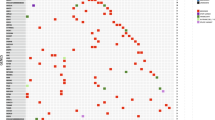Abstract
The p53 tumour suppressor protein plays a central role in the maintenance of genomic integrity. Mutations of the p53 gene are found in a number of canine cancers and many contribute to tumour formation. Here we describe isolation and expression of the complete wild type canine p53 cDNA. The encoded full length canine p53 protein displays strong sequence homology with p53 proteins from other higher vertebrates. Canine p53 protein produced in vitro was shown to recognize and bind to p53-specific DNA targets derived from the p21 and GADD45 promoters and to a consensus p53 binding site. We also show that canine p53 associates with oligonucleotides representing damaged DNA sites and undergoes proteolytic cleavage similar to that described for murine and human p53 proteins. Finally, we show that the canine p53 protein is able to transcriptionally activate a p53-dependent reporter gene in vivo. The results suggest that canine p53 is similar both in structure and function to human p53 and that canine cancer may provide a useful clinical model in the search for effective anti-cancer therapies based on p53.
Similar content being viewed by others
Author information
Authors and Affiliations
Rights and permissions
About this article
Cite this article
Veldhoen, N., Milner, J. Isolation of canine p53 cDNA and detailed characterization of the full length canine p53 protein. Oncogene 16, 1077–1084 (1998). https://doi.org/10.1038/sj.onc.1201863
Received:
Revised:
Accepted:
Published:
Issue Date:
DOI: https://doi.org/10.1038/sj.onc.1201863
- Springer Nature Limited
Keywords
This article is cited by
-
Nucleotide sequence of the porcine p53 cDNA, and the detection of recombinant porcine p53 expressed in vitro with a variety of anti-p53 antibodies
Oncogene (1999)
-
Identification of tumour-associated and germ line p53 mutations in canine mammary cancer
British Journal of Cancer (1999)
-
Allogeneic Astrocytoma In Immune Competent Dogs
Neoplasia (1999)
-
A novel exon within the mdm2 gene modulates translation initiation in vitro and disrupts the p53-binding domain of mdm2 protein
Oncogene (1999)




